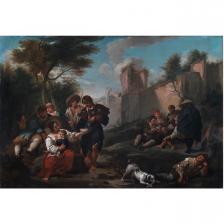Bambocciata, Pilgrims and Peasants next to the Aurelian Defensive Walls, in Rome
The subject
This painting depicts a view of the Rome’s Aurelian defensive wall, probably between the gates of Porta Latina and Porta Ardeatina, in the countryside where pilgrims and travelers used to stop for some rest, during their trips to or from the Eternal City. On the left of the canvas a group of peasants are recognizable in the foreground, seated under trees, close to a young woman holding a baby. The woman is receiving a drink from a pilgrim, recognizable by the shells hanging over his brown coat. On the right, a few young men are playing cards, while a dodgy character standing in the back, is watching them. On the lower part of the canvas, a young shepherd is resting while next to him a dog is biting a little bone.
The painting
This canvas showing a view of the Aurelian defensive walls, with pilgrims, peasants and cards players, executed on the second half of the 6th decade of 18th century, is an important addition to the works which originate from the collaboration between Paolo Anesi and Paolo Monaldi. Paolo Monaldi followed the path laid out by his teacher Andrea Locatelli, continuing in the 18th century with the Arcadia Landscapes and the “Bambocciata” a model developed during the previous century. As is clear in this canvas, he portrayed the world of the unassuming with idyllic and playful spirit, using bright and vivid colors. His favorite subjects were peasant dances, tarantellas, inn’s scenes with attendants and cards players, showing out of context, isolated scenes, related to a country heaven, free of any violence or eroticism. The peasants depicted by Monaldi are always happy and joyful, placed into genuine rural scenes, which are created with a fresh and dynamic touch. The cooperation between Monaldi and Anesi was deeply investigated by Busiri Vici, in his fundamental study entitled “Trittico Paesistico Romano” (Roman Landscape Triptych) – 1976 – emphasizing analogies and differences of the two artists who can be reasonably considered among the principal artists of the 18th century roman Arcadia-landscapes school. One of the first exemplum of this “joint-venture” is documented by the fine “View of Campidoglio and Campo Vaccino with church of Ss. Luca e Martina” (Rome, Palazzo Braschi Museum) where the division of labor is quite evident: Anesi realized the landscapes and the ruins leaving to Monaldi the decorative set and the creation of the shepherd’s Arcadia world, of which he was one of the main representative. This canvas perfectly reflects this partition. To Paolo Anesi is attributed the multifaceted composition of the landscape and the painting of the defensive walls. Paolo Monaldi instead created the figures which animate, with a calibrated balance, the composition, all realized with vivid realistic taste and with marked sense of color. The painting’s formal, stylistic and chronological comparative point is undoubtedly, the decoration ordered by Cardinal Flavio Chigi, outside Porta Salaria, the highest expression of the artist’s collaborative work. This commission included four large canvases which disappeared around 1965; lost afterwards in the art market, these canvases recently appeared in a auction. As Andrea Busiri Vici correctly underlined, in the Villa Chigi commission Paolo Anesi confirms his role as main interpreter of landscape painting in Rome, during the second half of the century, whilst Paolo Monaldi arises as the more appropriate representative of his age, indicating him as a figure painter of exceptionally good taste, foreshadowing Goya’s cardboards, today in the Prado Museum, Madrid. The formal and esthetic quality of the present view leads to consideration not far from those expressed by Busiri regarding the Chigi commission. Similarities and close correspondence of the characters depicted, poses and patterns suggest the hypothesis that this painting was created during the same period, when the two artists were collaborating closely, with the opportunity to exchange ideas and delicate suggestions. For example, the young woman holding a baby, she is a peculiar model in Paolo Monaldi’s figurative world. We also find her in a canvas from the Chigi collection: Ideal Landscape with Ancient Ruins, where, instead of a pilgrim, a peasant is offering to drink to a seated woman nursing a baby. The composition set of this view brings to a necessary comparison with “Ideal Landscape with Ancient Ruins” from the Chigi commission, in particular on the ruins rendering, painted by Anesi like a dreamy vision. The complicated pattern used by Anesi and Monaldi in the Chigi paintings is more simplified in this view to support a smaller formal score, creating a small countryside idyll, in which, not far from the eco of the popular roman drama, the arcadic vision of the world and the serene representation of peasant life, is about to give birth to one of the most tormented season of the following romantic landscape.







